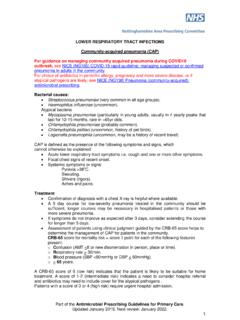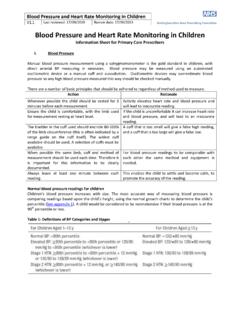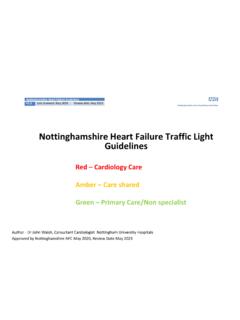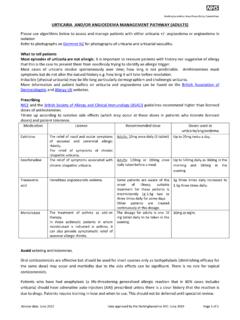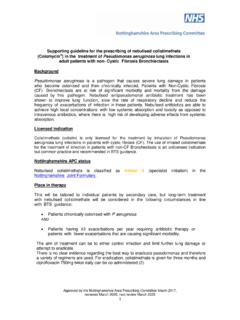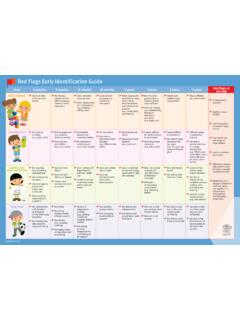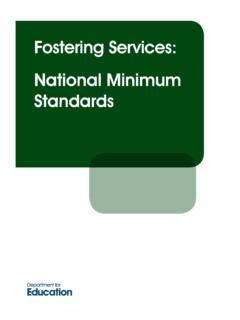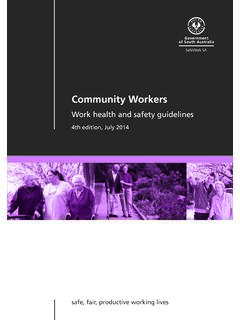Transcription of The Nottinghamshire and Nottingham Guidelines for Care in ...
1 Nottinghamshire Guidelines for Care in the Last Year of Life Last reviewed: 11/12/2020 Review date: 31/03/2022 Guidelines for Care in the Last Year of Life Back to contents Page 1 of 31 The Nottinghamshire and Nottingham Guidelines for Care in the Last Year of Life A Guide for Professionals This guide was produced in partnership between: Nottinghamshire Healthcare NHS Foundation Trust | Nottinghamshire Area Prescribing Committee | Nottingham University Hospitals NHS Trust | Sherwood Forest Hospitals NHS Foundation Trust | Nottingham CityCare Partnership | NHS Bassetlaw CCG Nottinghamshire Guidelines for Care in the Last Year of Life Last reviewed: 11/12/2020 Review date: 31/03/2022 Guidelines for Care in the Last Year of Life Back to contents Page 2 of 31 Contents Page Foreword 3 Introduction 4 Figure 1: Flow Chart to illustrate End of Life Planning 6 Figure 2: End of Life Planning: Details of Care Provision 7 Prognosis of less than 1 year 8 Prognosis of less than 6 months 11 Prognosis of a few weeks 12 Prognosis of days or hours 13 Care after death 16 Additional services to meet individual needs 16 Specialist Palliative Care 16 Audit 16 Care Quality Commission and End of Life Care 17 Appendices.
2 1a Priorities for Care of the Dying Person 18 1b Symptom Control and Anticipatory Prescribing 20 1c Symptom Control and Anticipatory Prescribing in Severe Renal Failure 23 1d Symptom Control and Anticipatory Prescribing in Severe Hepatic Disease 26 1e Palliative Care Stockist List 28 Glossary 29 References 30 Useful Information and Web Links 30 Acknowledgements 31 For summary of recent changes to the document, see version control (pg. 17). Nottinghamshire Guidelines for Care in the Last Year of Life Last reviewed: 11/12/2020 Review date: 31/03/2022 Guidelines for Care in the Last Year of Life Back to contents Page 3 of 31 Foreword Caring for people who are close to death demands compassion, kindness and a skilled application of knowledge.
3 In 2013 an independent review of care given to dying patients in England, More Care Less Pathway , was published1. In response, the Leadership Alliance for Care of Dying People (LACDP) issued One Chance to Get it Right (June 2014), which sets out the approach to caring for dying people that should henceforward be adopted in England2. The approach focuses on achieving 5 Priorities for Care , which should be applied irrespective of the place in which someone is dying: hospital, hospice, own or other home and during transfers between different settings. The aim of this guidance is to ensure the provision of high quality End of Life Care. Representatives of providers in Nottinghamshire and Bassetlaw have collectively developed this guidance, which describes how we must support our patients and their families when someone is believed to be in the last year of life.
4 All staff caring for dying people must ensure that they are aware of, and follow, local guidance and best practice. The evidence on which this guidance is based will continue to evolve, and will be reviewed at regular intervals. We encourage staff to sit down and listen to their patient and their carer, document the discussion in the patient record and act on the patient preferences. Annexed to One Chance to Get it Right are separate documents which set out the duties and responsibilities of health and care staff who are involved in the care of dying people3 (aligned with professional regulatory guidance and relevant legal requirements, including the obligations on staff set out in the Mental Capacity Act 2005); and implementation guidance for service providers and commissioners4 who have a responsibility to ensure that staff have the right training and support to deliver care of the dying person in a safe, effective and person-centred way, whatever the setting.
5 This guidance promotes: The early identification of people approaching the end of life and initiating discussions about preferences for End of Life Care Care planning: assessing needs and preferences, agreeing a patient and carer care plan Coordination of care Delivery of high quality services in all locations Management of care in the last days of life Care after death Supporting carers both during a person s illness and after their death Nottinghamshire Guidelines for Care in the Last Year of Life Last reviewed: 11/12/2020 Review date: 31/03/2022 Guidelines for Care in the Last Year of Life Back to contents Page 4 of 31 Introduction End of Life Care is the responsibility of all health and social care providers that care for: People with less than one year to live People with chronic progressive eventually fatal illness People diagnosed with the condition from which they will eventually die.
6 These include long term conditions, organ failure, cancer, cerebral-vascular illness, dementia and progressive neurological conditions. This includes patients whose death is imminent (expected within a few hours or days). The provision of End of Life Care involves palliative care, aiming to achieve the best quality of life for patients and their families. A range of people provide this care, including informal carers , medical, nursing and allied health staff and social care professionals. The focus of palliative care is teamwork, providing support whatever the setting whether in people s own homes, hospital, hospice, palliative care unit or care homes. Palliative Care includes:- Advance Care Planning Symptom control Rehabilitation to maximise social participation Emotional and social support By focusing on these areas we can help people to have a good quality of life (live well) until they die.
7 Understanding and delivering patient choice is central to excellent care at the end of life. Ability to achieve patient choice may be used to measure quality of service. In relation to place of death, national statistics demonstrate a disparity between patients preferred place of death and their actual place of death. Although when asked, over 50% of patient s state they would prefer to die at home, but many do not achieve this aim. The choices that patients make can change with time as health and support needs change. A patient with months to live is likely to have different priorities to a patient believed to be in the final hours of life. Excellent communication with patients and families will allow professionals to understand individual preferences and to work together to develop plans for End of Life Care.
8 Resources must be in place to adapt to a patient s evolving choices. Good quality Advance Care Planning will help to ensure that expectations are as realistic as possible. Delivering genuine choice presents real challenges. Teamwork is crucial. By matching need with resource, services can be more effectively and efficiently delivered. If well-planned care is available in the community, fewer patients will need admissions to specialist services such as hospitals or hospices. The purpose of this guidance is to support patients, carers and professionals to develop individual plans for End of Life Care. The Flowchart to illustrate End of Life Planning (Figure 1) is founded on the use of evidence based practice, and the principles of Advance Care Planning.
9 This promotes a management plan to optimise quality of life using recognised tools Gold Standards Framework (GSF) Nottinghamshire Guidelines for Care in the Last Year of Life Last reviewed: 11/12/2020 Review date: 31/03/2022 Guidelines for Care in the Last Year of Life Back to contents Page 5 of 31 The aim is to improve palliative care provided by the whole primary care team by optimising continuity of care, teamwork, advance planning (including out of hours), symptom control and patient, carer and staff support. Five Priorities for Care of the Dying Person Promoting recognition of the diagnosis of dying; communication with patient and carer; achieving choice, supporting families and documentation of an individual care plan.
10 Electronic Palliative Care Coordination System (EPaCCS) An electronic communication system to coordinate care between all health and social care providers The Recommended Summary Plan for Emergency Care and Treatment (ReSPECT) Nottinghamshire Healthcare has signed up to the National Resuscitation Council (2017) national initiative The Recommended Summary Plan for Emergency Care and Treatment (ReSPECT) . ReSPECT is a process that creates personalised recommendations for a person s clinical care in a future emergency in which they are unable to make or express choices. It provides health and care professionals responding to that emergency with a summary of recommendations to help them to make immediate decisions about that person s care and treatment.


